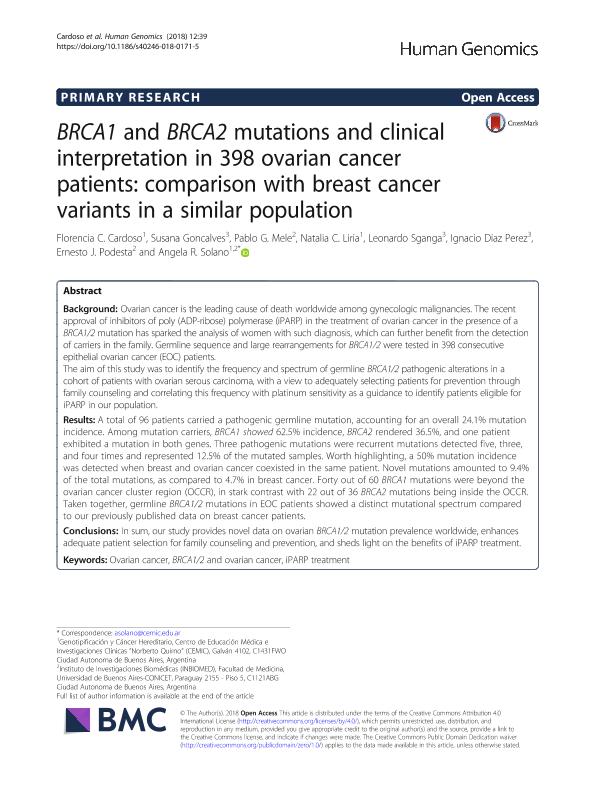Mostrar el registro sencillo del ítem
dc.contributor.author
Cardozo, Florencia C.
dc.contributor.author
Goncalves, Susana
dc.contributor.author
Mele, Pablo Gustavo

dc.contributor.author
Liria, Natalia C.
dc.contributor.author
Sganga, Leonardo

dc.contributor.author
Diaz Perez, Ignacio
dc.contributor.author
Podesta, Ernesto Jorge

dc.contributor.author
Podesta, Ernesto Jorge

dc.date.available
2019-10-21T21:21:59Z
dc.date.issued
2018-01
dc.identifier.citation
Cardozo, Florencia C.; Goncalves, Susana; Mele, Pablo Gustavo; Liria, Natalia C.; Sganga, Leonardo; et al.; BRCA1 and BRCA2 mutations and clinical interpretation in 398 ovarian cancer patients: Comparison with breast cancer variants in a similar population; BioMed Central; Human Genomics; 12; 39; 1-2018; 1-8
dc.identifier.issn
1479-7364
dc.identifier.uri
http://hdl.handle.net/11336/86770
dc.description.abstract
Background: Ovarian cancer is the leading cause of death worldwide among gynecologic malignancies. The recent approval of inhibitors of poly (ADP-ribose) polymerase (iPARP) in the treatment of ovarian cancer in the presence of a BRCA1/2 mutation has sparked the analysis of women with such diagnosis, which can further benefit from the detection of carriers in the family. Germline sequence and large rearrangements for BRCA1/2 were tested in 398 consecutive epithelial ovarian cancer (EOC) patients. The aim of this study was to identify the frequency and spectrum of germline BRCA1/2 pathogenic alterations in a cohort of patients with ovarian serous carcinoma, with a view to adequately selecting patients for prevention through family counseling and correlating this frequency with platinum sensitivity as a guidance to identify patients eligible for iPARP in our population. Results: A total of 96 patients carried a pathogenic germline mutation, accounting for an overall 24.1% mutation incidence. Among mutation carriers, BRCA1 showed 62.5% incidence, BRCA2 rendered 36.5%, and one patient exhibited a mutation in both genes. Three pathogenic mutations were recurrent mutations detected five, three, and four times and represented 12.5% of the mutated samples. Worth highlighting, a 50% mutation incidence was detected when breast and ovarian cancer coexisted in the same patient. Novel mutations amounted to 9.4% of the total mutations, as compared to 4.7% in breast cancer. Forty out of 60 BRCA1 mutations were beyond the ovarian cancer cluster region (OCCR), in stark contrast with 22 out of 36 BRCA2 mutations being inside the OCCR. Taken together, germline BRCA1/2 mutations in EOC patients showed a distinct mutational spectrum compared to our previously published data on breast cancer patients. Conclusions: In sum, our study provides novel data on ovarian BRCA1/2 mutation prevalence worldwide, enhances adequate patient selection for family counseling and prevention, and sheds light on the benefits of iPARP treatment.
dc.format
application/pdf
dc.language.iso
eng
dc.publisher
BioMed Central

dc.rights
info:eu-repo/semantics/openAccess
dc.rights.uri
https://creativecommons.org/licenses/by-nc-sa/2.5/ar/
dc.subject
BRCA1/2 AND OVARIAN CANCER
dc.subject
IPARP TREATMENT
dc.subject
OVARIAN CANCER
dc.subject.classification
Oncología

dc.subject.classification
Medicina Clínica

dc.subject.classification
CIENCIAS MÉDICAS Y DE LA SALUD

dc.title
BRCA1 and BRCA2 mutations and clinical interpretation in 398 ovarian cancer patients: Comparison with breast cancer variants in a similar population
dc.type
info:eu-repo/semantics/article
dc.type
info:ar-repo/semantics/artículo
dc.type
info:eu-repo/semantics/publishedVersion
dc.date.updated
2019-10-15T19:39:48Z
dc.journal.volume
12
dc.journal.number
39
dc.journal.pagination
1-8
dc.journal.pais
Reino Unido

dc.journal.ciudad
London
dc.description.fil
Fil: Cardozo, Florencia C.. Centro de Educación Médica e Investigaciones Clínicas “Norberto Quirno”; Argentina
dc.description.fil
Fil: Goncalves, Susana. AstraZeneca Argentina MC; Argentina
dc.description.fil
Fil: Mele, Pablo Gustavo. Consejo Nacional de Investigaciones Científicas y Técnicas. Oficina de Coordinación Administrativa Houssay. Instituto de Investigaciones Biomédicas. Universidad de Buenos Aires. Facultad de Medicina. Instituto de Investigaciones Biomédicas; Argentina
dc.description.fil
Fil: Liria, Natalia C.. Centro de Educación Médica e Investigaciones Clínicas “Norberto Quirno”; Argentina
dc.description.fil
Fil: Sganga, Leonardo. AstraZeneca Argentina MC; Argentina
dc.description.fil
Fil: Diaz Perez, Ignacio. AstraZeneca Argentina MC; Argentina
dc.description.fil
Fil: Podesta, Ernesto Jorge. Consejo Nacional de Investigaciones Científicas y Técnicas. Oficina de Coordinación Administrativa Houssay. Instituto de Investigaciones Biomédicas. Universidad de Buenos Aires. Facultad de Medicina. Instituto de Investigaciones Biomédicas; Argentina
dc.description.fil
Fil: Podesta, Ernesto Jorge. Consejo Nacional de Investigaciones Científicas y Técnicas. Oficina de Coordinación Administrativa Houssay. Instituto de Investigaciones Biomédicas. Universidad de Buenos Aires. Facultad de Medicina. Instituto de Investigaciones Biomédicas; Argentina. Centro de Educación Médica e Investigaciones Clínicas “Norberto Quirno”; Argentina
dc.journal.title
Human Genomics
dc.relation.alternativeid
info:eu-repo/semantics/altIdentifier/doi/http://dx.doi.org/10.1186/s40246-018-0171-5
dc.relation.alternativeid
info:eu-repo/semantics/altIdentifier/url/https://humgenomics.biomedcentral.com/articles/10.1186/s40246-018-0171-5
Archivos asociados
